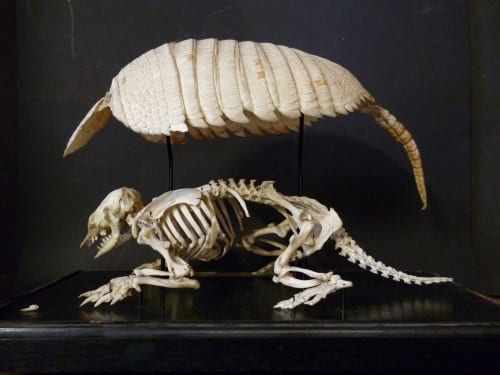Specimen of the week 349: The nine-banded armadillo
By Christopher J Wearden, on 29 June 2018
Happy Friday to all Specimen of the Week readers. After a recent road trip across the southern United States, I’m bringing you a curious creature that can be found all the way from Texas to Tennessee. They are known for their distinctive shape and defensive abilities, but as we’ll see, there is more than just the shell to admire about these animals. It’s our very own…
**Nine-banded armadillo (skeleton and carapace)**
The nine-banded armadillo (Dasypus novemcinctus) is a mammal found in North, Central and South America. There are 21 known species of armadillo; the name was applied by the Spanish explorers in America and means ‘small armoured thing’. The armadillo family (Dasydodipae) are the only surviving member of the family Cingulata, which includes a number of extinct, armoured, armadillo-like animals. Nine-banded armadillos are primarily insectivores and feed on ants, termites and small invertebrates. A lesser part of their diet however is comprised of small reptiles and amphibians, as well as the eggs of birds. The nine-banded armadillo was designated as the state mammal of Texas in 1995.
Stop, drop and roll
The most well-known feature of the armadillo is, of course, its armour. The armadillo’s hard shell (called a carapace) is made of bone and a tough tissue coating. The carapace serves a defensive function and protects armadillos from predators which share its natural habitat. Contrary to popular belief however, not all armadillos are capable of rolling into a complete ball. Nine banded-armadillos have long tails which prevent them forming this shape, whereas three banded armadillos have a short tail which tucks in, allowing them to form a ball shape.

A nine-banded armadillo in the Green Swamp, Flordia. Image by http://www.birdphotos.com via Wikimedia Commons. CC-BY-3.0

A Southern three-banded armadillo. Image by Tim Pierce via Wikimedia Commons. CC-BY-2.0
Despite not being able to roll into a ball, nine-banded armadillos are well protected from predators. Their carapace is extremely tough and even carnivores with strong jaws are unable to breach it. By utilising their shell they can protect their most vulnerable areas, such as the soft underbelly.
Fab Four
Armadillos have a reproductive trait which is unique among placental mammals (mammals which give birth to live young who are nourished before birth in their mother’s uterus). Females always give birth to quadruplets, and the offspring are always the same sex because they developed from the same egg. They are born physically identical to each other and are similar in appearance to adults apart from their soft armour. Until this armour fully hardens they are vulnerable to predators such as coyotes, foxes and alligators.
Natural born swimmers
Although you might not think it by looking at them, nine-banded armadillos are actually very good swimmers. Typically when threatened they will use their carapace or burrow into the ground, but they are also capable of swimming away from predators. They can hold their breath for up to six minutes and walk across the bottom of rivers and streams, which is very useful for evading many of the land-based predators which hunt them.
Christopher Wearden is the Visitor Services Assistant at the Grant Museum
References
https://www.nationalgeographic.com/animals/mammals/group/armadillos/
https://www.nwf.org/Educational-Resources/Wildlife-Guide/Mammals/Nine-Banded-Armadillo
 Close
Close


